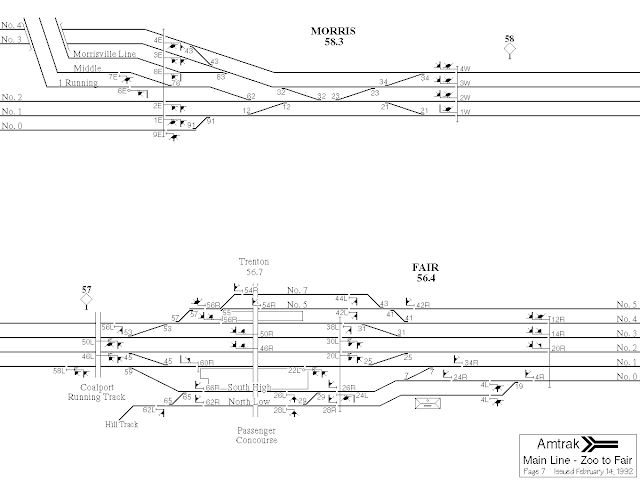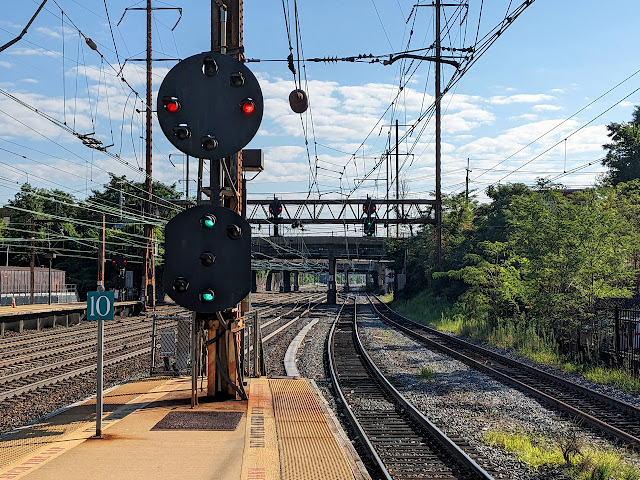A little while back I discussed the evolution of NORTH PHILADELPHIA interlocking from its construction in 1914 to its disestablishment in 2005. Early urban interlockings such as NORTH PHILADELPHIA were colorful characters with all sorts of extra infrastructure to handle not only the main line traffic, but also stuff like industrial switching, yard and light engine moves. FAIR tower in Trenton, NJ is not only NORTH PHILADELPHIA's sibling in appearance, but also in its arc through history. While I don't want to get too deep into the history and evolution of FAIR, I will say that it was drastically expanded in the 1930's, then entered a series of successive diets in the late PRR, Penn Central and Amtrak eras before the tower was closed around 1994.
In its second to last iteration that lasted from around 1990 to about 2020, FAIR had lost all of the double slips and freight support it had maintains up through the end of mineral traffic on the Belvidere and Delaware line. It's primary function was that of a passenger terminal for the Philly and New York area commuter services that terminated there. The two remaining quirky features were two additional tracks at the far northern and northerner limits of the right of way. Track 7 was used to store SEPTA equipment, while "North Low Track" served as an extra place to stash New York bound peak period trains overnight. Below you can see how the plant changes from its late PRR configuration to post CTEC configuration.
The area of interest is the North Low and Hill Tracks. The Hill Track used to connect with the Bordentown Secondary to Camden which saw limited passenger service like the famed Nelly Bly NYC to Atlantic City express train. In the commuter era that was used as precious storage space, keeping alive the old configuration that used to serve Doodlebugs that would run into Trenton from rural South Jersey.
While eastbound movements out of North Low could be made via the "Wall Track" past the tower, this involved a Restricted speed signal. The preferred option was the 86 switch protected by the 6BE and 8BE signals. This was located at the eastern end of the platform with 4 dwarf signals protecting the single low speed switch. One of the dwarfs was mounted on a striped stick for better visibility.
At the west end of the platform was another left-hand turnout, the 86W switch and associated 6BW and 8BW dwarf signals. You are seeing things right in this only allowed for North Low access from the hill track. This became an issue when around 2005 NJT opened up its Morrisville Yard west of Trenton in Pennsylvania, turning all of the terminal traffic that needed to be shuffled about into run-through traffic. Trains arriving from Morrisville could not access the North Low and as you can see from the rust, it became disused.
Starting in 2019, Amtrak brought the rationalization hammer down on this legacy configuration. The 86W switch was reversed, the Hill Track was removed and the 16 switch from Main Track 1 was fixed up for higher speeds. Now trains from Morrisville can access the North Low, making it potentially useful again. Unfortunately the next step came with the same interlocking refresh that removed all of FAIR's pneumatic point machines. The 86 switch and its associated signals were completely removed.
Trains using North Low will now have to take the slow route past FAIR tower and them on 0 Track to HAM interlocking, but as you can see from the grass, it is unlikely there will be a need for North Low any time soon. While this all makes sense, especially in the age where efficiency is more and more important, the 86 switch and its dwarf signals are still a loss worth noting.









Re "One of the dwarfs was mounted on a striped stick for better visibility.": If you mean "better visibility for a train driver", I'd doubt that; if you mean "better visibility for people walking thereabouts", then I'm with you: This signal is standing on a platform which might either be used by passengers; or at least by railroad people as a safe path near the tracks - and safety concerns would prohibit low items (like a dwarf signal) on the bottom where one could stumble over.
ReplyDeleteH.M.